Business Strategy and Strategic Management Plan for Klarna Bank AB
VerifiedAdded on 2023/01/12
|18
|5525
|61
Report
AI Summary
This report provides a comprehensive strategic analysis of Klarna Bank AB, a leading financial institution. It begins with an introduction to business strategy and its importance, then moves on to assess the external environment using PESTLE analysis, evaluating political, economic, social, technological, legal, and environmental factors impacting Klarna's operations. The report then delves into the internal capabilities of the organization, employing VRIO and McKinsey's 7S models to identify strengths and weaknesses. Industry analysis is conducted using Porter's Five Forces Model to understand the competitive landscape. Finally, the report evaluates various strategic theories and concepts to formulate strategic directions, objectives, and tactical actions, culminating in a strategic management plan for Klarna. The analysis covers various aspects of Klarna's operations, including financial services, payment solutions, and its position in the UK and other markets, providing valuable insights for strategic decision-making.
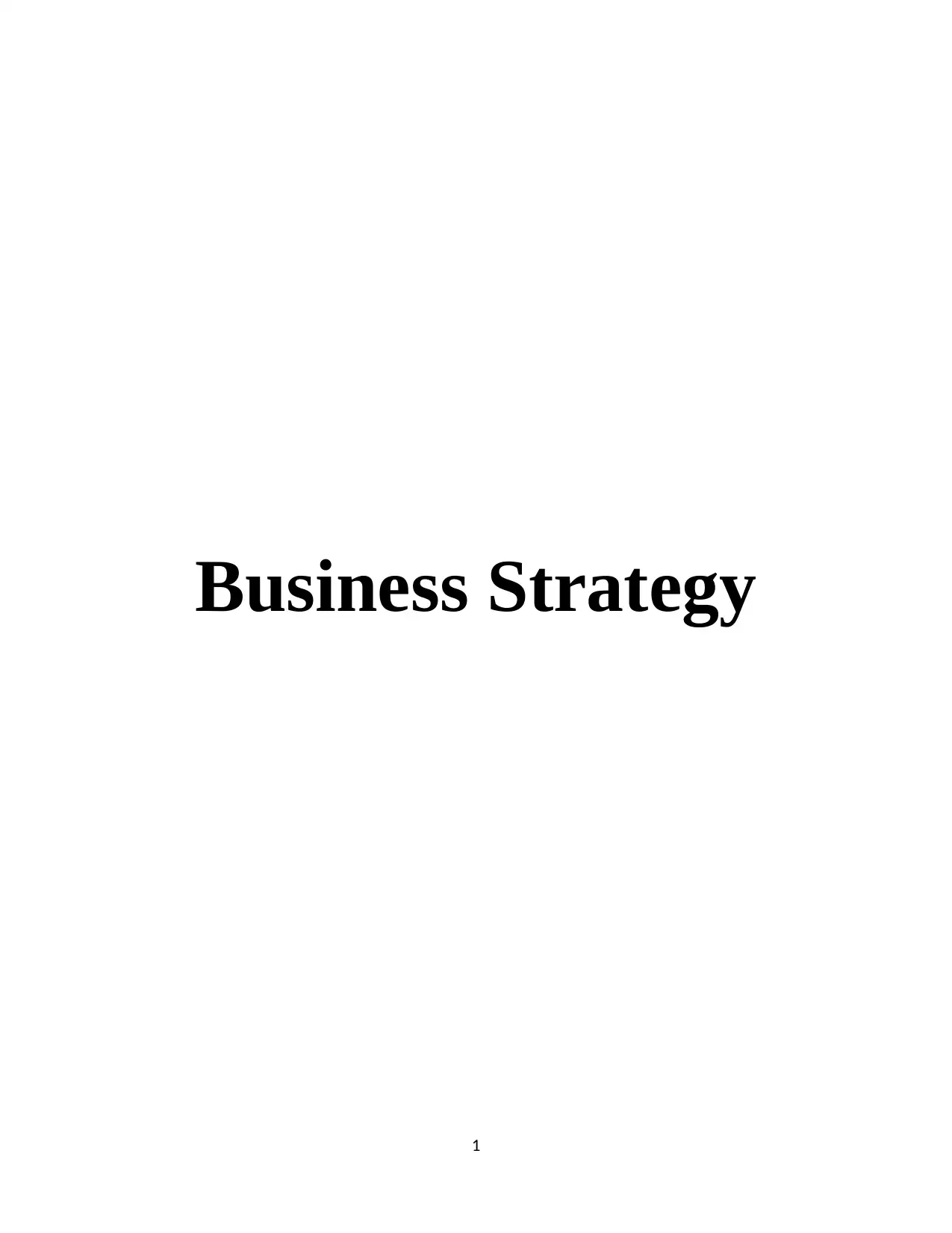
Business Strategy
1
1
Paraphrase This Document
Need a fresh take? Get an instant paraphrase of this document with our AI Paraphraser
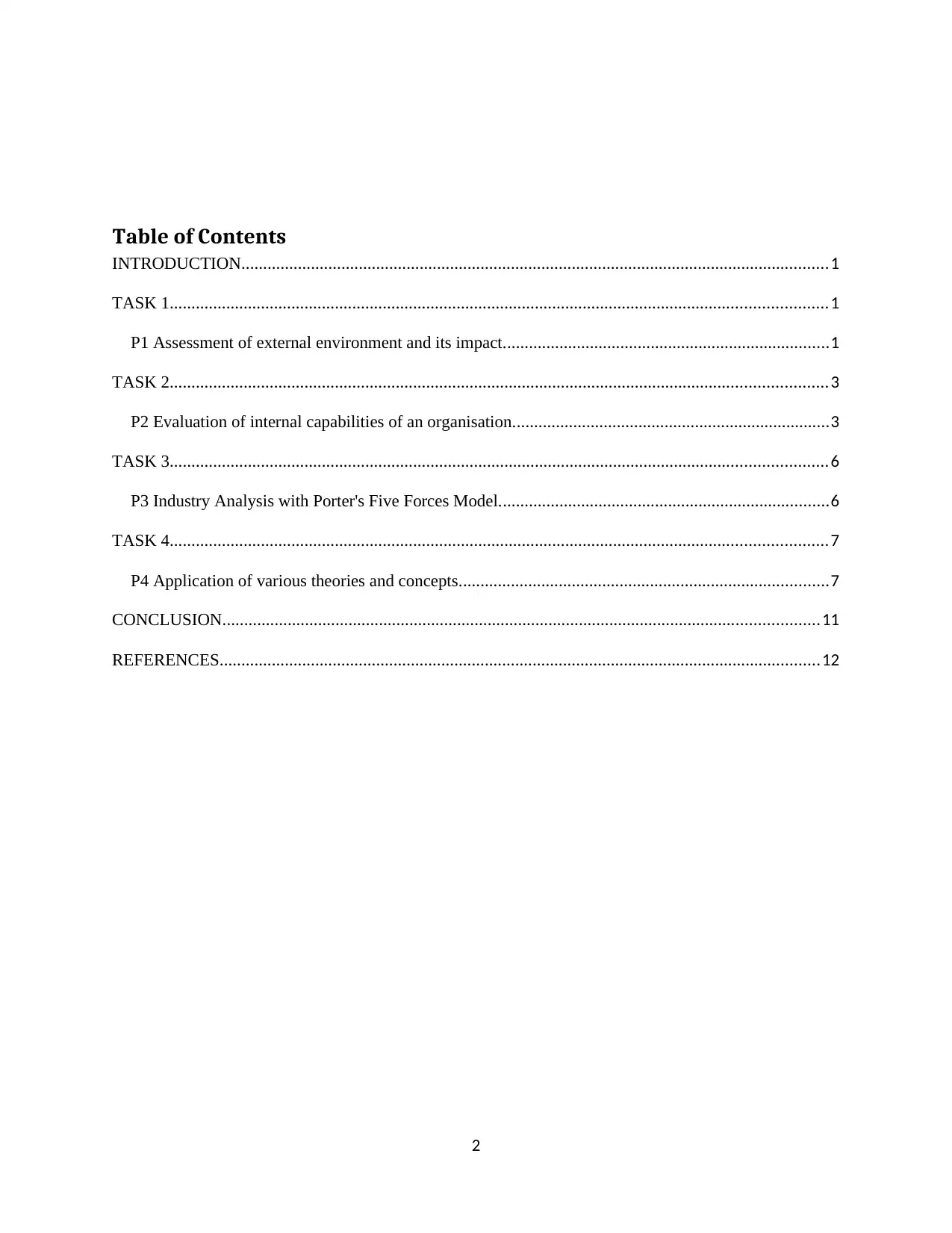
Table of Contents
INTRODUCTION.......................................................................................................................................1
TASK 1.......................................................................................................................................................1
P1 Assessment of external environment and its impact...........................................................................1
TASK 2.......................................................................................................................................................3
P2 Evaluation of internal capabilities of an organisation.........................................................................3
TASK 3.......................................................................................................................................................6
P3 Industry Analysis with Porter's Five Forces Model............................................................................6
TASK 4.......................................................................................................................................................7
P4 Application of various theories and concepts.....................................................................................7
CONCLUSION.........................................................................................................................................11
REFERENCES..........................................................................................................................................12
2
INTRODUCTION.......................................................................................................................................1
TASK 1.......................................................................................................................................................1
P1 Assessment of external environment and its impact...........................................................................1
TASK 2.......................................................................................................................................................3
P2 Evaluation of internal capabilities of an organisation.........................................................................3
TASK 3.......................................................................................................................................................6
P3 Industry Analysis with Porter's Five Forces Model............................................................................6
TASK 4.......................................................................................................................................................7
P4 Application of various theories and concepts.....................................................................................7
CONCLUSION.........................................................................................................................................11
REFERENCES..........................................................................................................................................12
2

3
⊘ This is a preview!⊘
Do you want full access?
Subscribe today to unlock all pages.

Trusted by 1+ million students worldwide
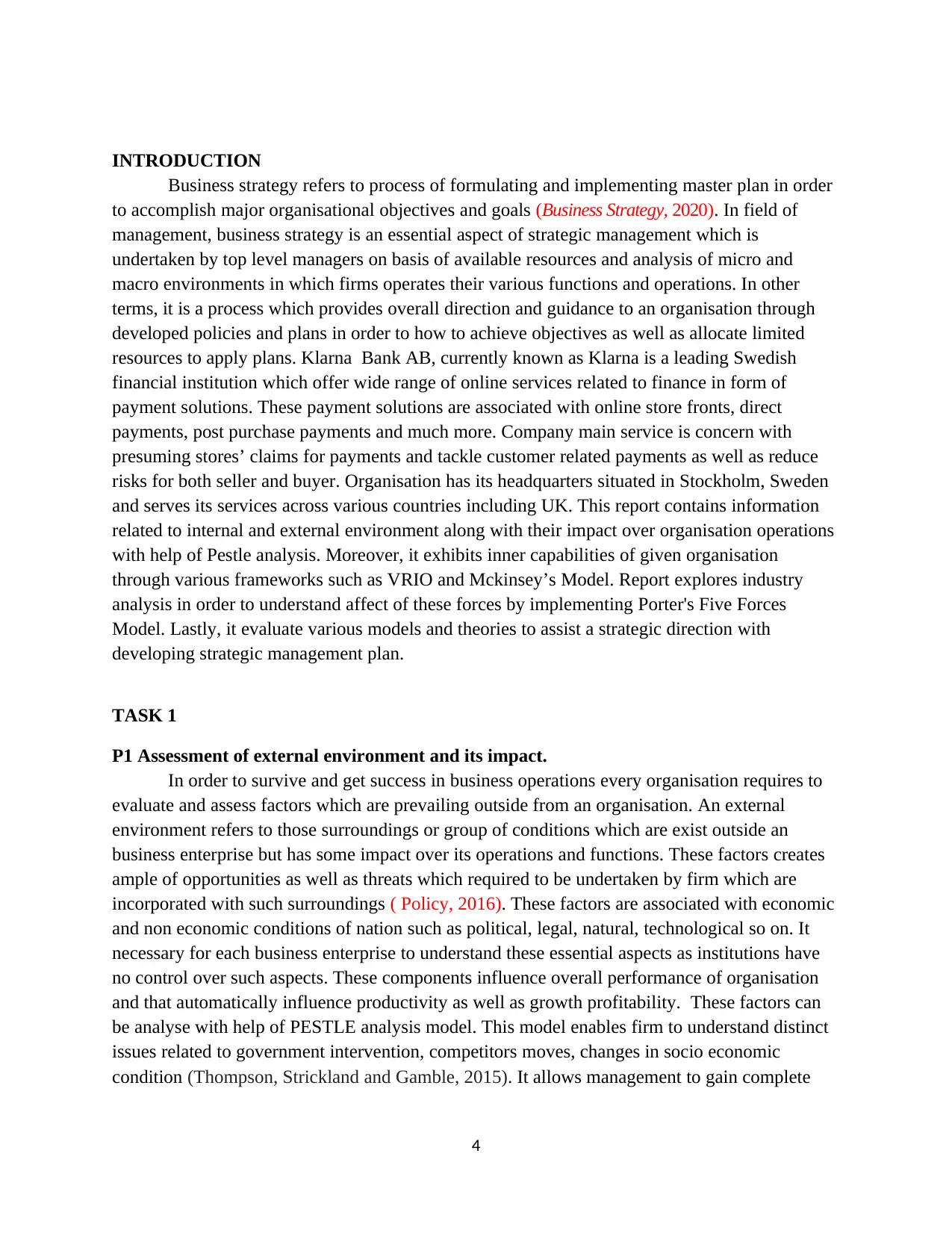
INTRODUCTION
Business strategy refers to process of formulating and implementing master plan in order
to accomplish major organisational objectives and goals (Business Strategy, 2020). In field of
management, business strategy is an essential aspect of strategic management which is
undertaken by top level managers on basis of available resources and analysis of micro and
macro environments in which firms operates their various functions and operations. In other
terms, it is a process which provides overall direction and guidance to an organisation through
developed policies and plans in order to how to achieve objectives as well as allocate limited
resources to apply plans. Klarna Bank AB, currently known as Klarna is a leading Swedish
financial institution which offer wide range of online services related to finance in form of
payment solutions. These payment solutions are associated with online store fronts, direct
payments, post purchase payments and much more. Company main service is concern with
presuming stores’ claims for payments and tackle customer related payments as well as reduce
risks for both seller and buyer. Organisation has its headquarters situated in Stockholm, Sweden
and serves its services across various countries including UK. This report contains information
related to internal and external environment along with their impact over organisation operations
with help of Pestle analysis. Moreover, it exhibits inner capabilities of given organisation
through various frameworks such as VRIO and Mckinsey’s Model. Report explores industry
analysis in order to understand affect of these forces by implementing Porter's Five Forces
Model. Lastly, it evaluate various models and theories to assist a strategic direction with
developing strategic management plan.
TASK 1
P1 Assessment of external environment and its impact.
In order to survive and get success in business operations every organisation requires to
evaluate and assess factors which are prevailing outside from an organisation. An external
environment refers to those surroundings or group of conditions which are exist outside an
business enterprise but has some impact over its operations and functions. These factors creates
ample of opportunities as well as threats which required to be undertaken by firm which are
incorporated with such surroundings ( Policy, 2016). These factors are associated with economic
and non economic conditions of nation such as political, legal, natural, technological so on. It
necessary for each business enterprise to understand these essential aspects as institutions have
no control over such aspects. These components influence overall performance of organisation
and that automatically influence productivity as well as growth profitability. These factors can
be analyse with help of PESTLE analysis model. This model enables firm to understand distinct
issues related to government intervention, competitors moves, changes in socio economic
condition (Thompson, Strickland and Gamble, 2015). It allows management to gain complete
4
Business strategy refers to process of formulating and implementing master plan in order
to accomplish major organisational objectives and goals (Business Strategy, 2020). In field of
management, business strategy is an essential aspect of strategic management which is
undertaken by top level managers on basis of available resources and analysis of micro and
macro environments in which firms operates their various functions and operations. In other
terms, it is a process which provides overall direction and guidance to an organisation through
developed policies and plans in order to how to achieve objectives as well as allocate limited
resources to apply plans. Klarna Bank AB, currently known as Klarna is a leading Swedish
financial institution which offer wide range of online services related to finance in form of
payment solutions. These payment solutions are associated with online store fronts, direct
payments, post purchase payments and much more. Company main service is concern with
presuming stores’ claims for payments and tackle customer related payments as well as reduce
risks for both seller and buyer. Organisation has its headquarters situated in Stockholm, Sweden
and serves its services across various countries including UK. This report contains information
related to internal and external environment along with their impact over organisation operations
with help of Pestle analysis. Moreover, it exhibits inner capabilities of given organisation
through various frameworks such as VRIO and Mckinsey’s Model. Report explores industry
analysis in order to understand affect of these forces by implementing Porter's Five Forces
Model. Lastly, it evaluate various models and theories to assist a strategic direction with
developing strategic management plan.
TASK 1
P1 Assessment of external environment and its impact.
In order to survive and get success in business operations every organisation requires to
evaluate and assess factors which are prevailing outside from an organisation. An external
environment refers to those surroundings or group of conditions which are exist outside an
business enterprise but has some impact over its operations and functions. These factors creates
ample of opportunities as well as threats which required to be undertaken by firm which are
incorporated with such surroundings ( Policy, 2016). These factors are associated with economic
and non economic conditions of nation such as political, legal, natural, technological so on. It
necessary for each business enterprise to understand these essential aspects as institutions have
no control over such aspects. These components influence overall performance of organisation
and that automatically influence productivity as well as growth profitability. These factors can
be analyse with help of PESTLE analysis model. This model enables firm to understand distinct
issues related to government intervention, competitors moves, changes in socio economic
condition (Thompson, Strickland and Gamble, 2015). It allows management to gain complete
4
Paraphrase This Document
Need a fresh take? Get an instant paraphrase of this document with our AI Paraphraser
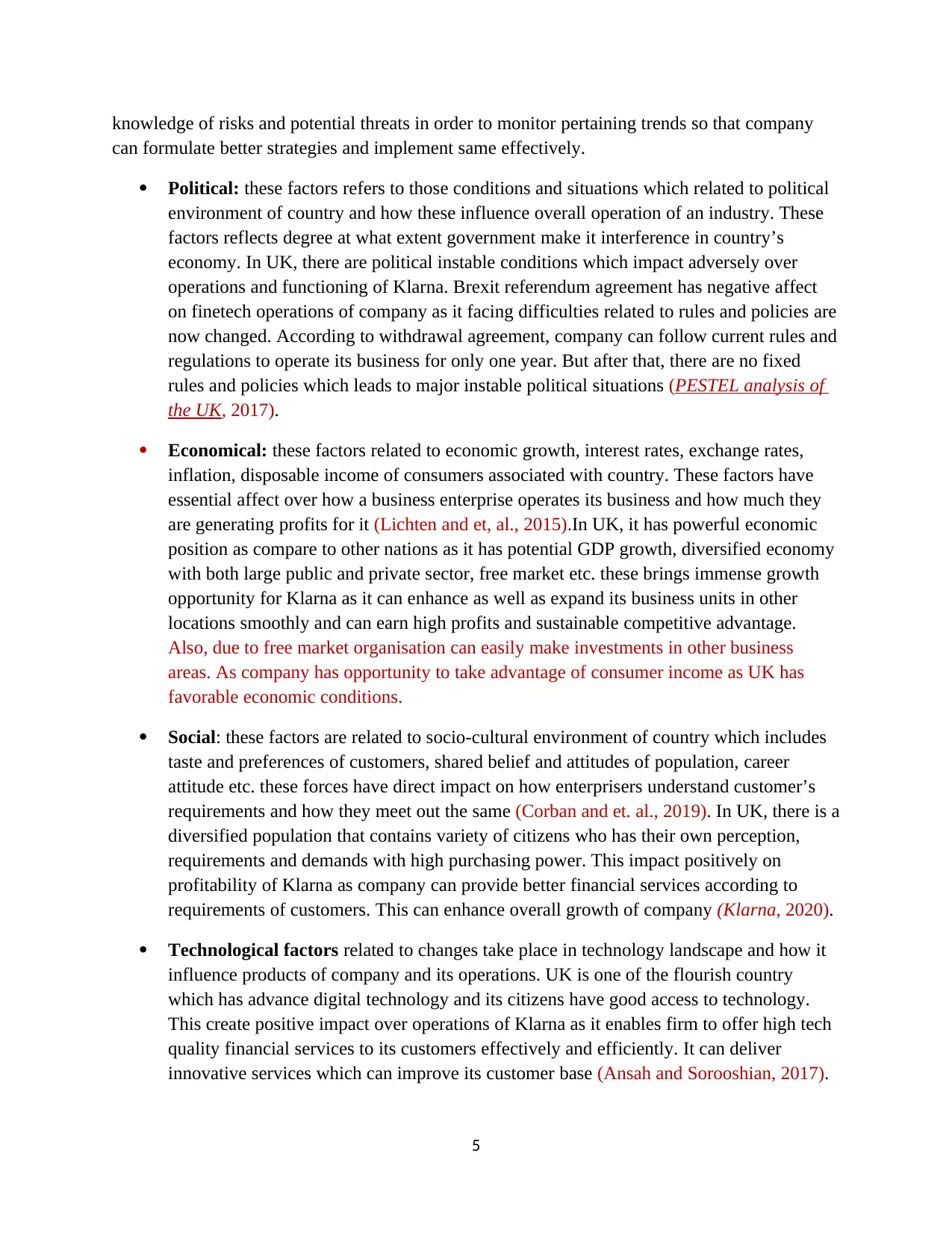
knowledge of risks and potential threats in order to monitor pertaining trends so that company
can formulate better strategies and implement same effectively.
Political: these factors refers to those conditions and situations which related to political
environment of country and how these influence overall operation of an industry. These
factors reflects degree at what extent government make it interference in country’s
economy. In UK, there are political instable conditions which impact adversely over
operations and functioning of Klarna. Brexit referendum agreement has negative affect
on finetech operations of company as it facing difficulties related to rules and policies are
now changed. According to withdrawal agreement, company can follow current rules and
regulations to operate its business for only one year. But after that, there are no fixed
rules and policies which leads to major instable political situations (PESTEL analysis of
the UK, 2017).
Economical: these factors related to economic growth, interest rates, exchange rates,
inflation, disposable income of consumers associated with country. These factors have
essential affect over how a business enterprise operates its business and how much they
are generating profits for it (Lichten and et, al., 2015).In UK, it has powerful economic
position as compare to other nations as it has potential GDP growth, diversified economy
with both large public and private sector, free market etc. these brings immense growth
opportunity for Klarna as it can enhance as well as expand its business units in other
locations smoothly and can earn high profits and sustainable competitive advantage.
Also, due to free market organisation can easily make investments in other business
areas. As company has opportunity to take advantage of consumer income as UK has
favorable economic conditions.
Social: these factors are related to socio-cultural environment of country which includes
taste and preferences of customers, shared belief and attitudes of population, career
attitude etc. these forces have direct impact on how enterprisers understand customer’s
requirements and how they meet out the same (Corban and et. al., 2019). In UK, there is a
diversified population that contains variety of citizens who has their own perception,
requirements and demands with high purchasing power. This impact positively on
profitability of Klarna as company can provide better financial services according to
requirements of customers. This can enhance overall growth of company (Klarna, 2020).
Technological factors related to changes take place in technology landscape and how it
influence products of company and its operations. UK is one of the flourish country
which has advance digital technology and its citizens have good access to technology.
This create positive impact over operations of Klarna as it enables firm to offer high tech
quality financial services to its customers effectively and efficiently. It can deliver
innovative services which can improve its customer base (Ansah and Sorooshian, 2017).
5
can formulate better strategies and implement same effectively.
Political: these factors refers to those conditions and situations which related to political
environment of country and how these influence overall operation of an industry. These
factors reflects degree at what extent government make it interference in country’s
economy. In UK, there are political instable conditions which impact adversely over
operations and functioning of Klarna. Brexit referendum agreement has negative affect
on finetech operations of company as it facing difficulties related to rules and policies are
now changed. According to withdrawal agreement, company can follow current rules and
regulations to operate its business for only one year. But after that, there are no fixed
rules and policies which leads to major instable political situations (PESTEL analysis of
the UK, 2017).
Economical: these factors related to economic growth, interest rates, exchange rates,
inflation, disposable income of consumers associated with country. These factors have
essential affect over how a business enterprise operates its business and how much they
are generating profits for it (Lichten and et, al., 2015).In UK, it has powerful economic
position as compare to other nations as it has potential GDP growth, diversified economy
with both large public and private sector, free market etc. these brings immense growth
opportunity for Klarna as it can enhance as well as expand its business units in other
locations smoothly and can earn high profits and sustainable competitive advantage.
Also, due to free market organisation can easily make investments in other business
areas. As company has opportunity to take advantage of consumer income as UK has
favorable economic conditions.
Social: these factors are related to socio-cultural environment of country which includes
taste and preferences of customers, shared belief and attitudes of population, career
attitude etc. these forces have direct impact on how enterprisers understand customer’s
requirements and how they meet out the same (Corban and et. al., 2019). In UK, there is a
diversified population that contains variety of citizens who has their own perception,
requirements and demands with high purchasing power. This impact positively on
profitability of Klarna as company can provide better financial services according to
requirements of customers. This can enhance overall growth of company (Klarna, 2020).
Technological factors related to changes take place in technology landscape and how it
influence products of company and its operations. UK is one of the flourish country
which has advance digital technology and its citizens have good access to technology.
This create positive impact over operations of Klarna as it enables firm to offer high tech
quality financial services to its customers effectively and efficiently. It can deliver
innovative services which can improve its customer base (Ansah and Sorooshian, 2017).
5
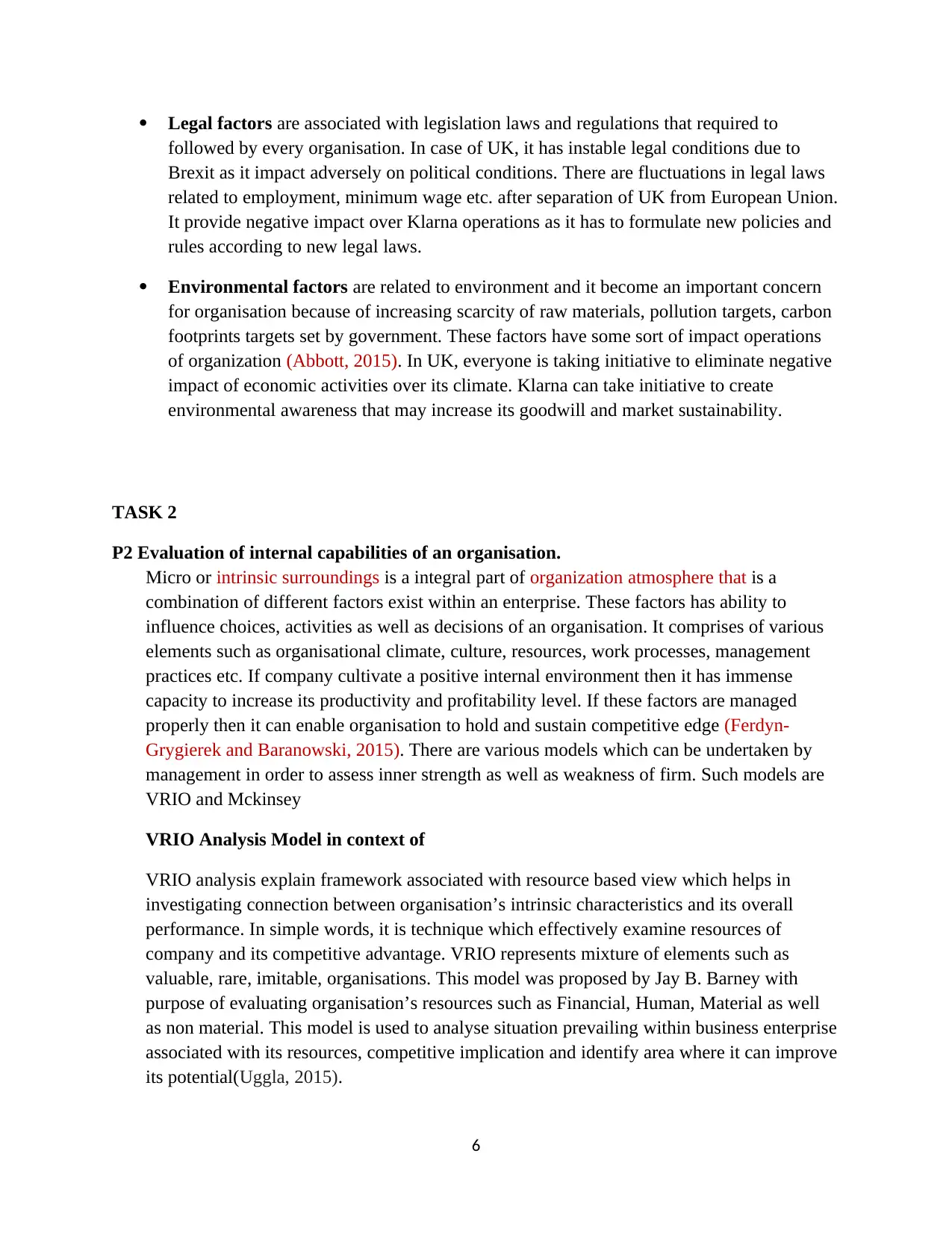
Legal factors are associated with legislation laws and regulations that required to
followed by every organisation. In case of UK, it has instable legal conditions due to
Brexit as it impact adversely on political conditions. There are fluctuations in legal laws
related to employment, minimum wage etc. after separation of UK from European Union.
It provide negative impact over Klarna operations as it has to formulate new policies and
rules according to new legal laws.
Environmental factors are related to environment and it become an important concern
for organisation because of increasing scarcity of raw materials, pollution targets, carbon
footprints targets set by government. These factors have some sort of impact operations
of organization (Abbott, 2015). In UK, everyone is taking initiative to eliminate negative
impact of economic activities over its climate. Klarna can take initiative to create
environmental awareness that may increase its goodwill and market sustainability.
TASK 2
P2 Evaluation of internal capabilities of an organisation.
Micro or intrinsic surroundings is a integral part of organization atmosphere that is a
combination of different factors exist within an enterprise. These factors has ability to
influence choices, activities as well as decisions of an organisation. It comprises of various
elements such as organisational climate, culture, resources, work processes, management
practices etc. If company cultivate a positive internal environment then it has immense
capacity to increase its productivity and profitability level. If these factors are managed
properly then it can enable organisation to hold and sustain competitive edge (Ferdyn-
Grygierek and Baranowski, 2015). There are various models which can be undertaken by
management in order to assess inner strength as well as weakness of firm. Such models are
VRIO and Mckinsey
VRIO Analysis Model in context of
VRIO analysis explain framework associated with resource based view which helps in
investigating connection between organisation’s intrinsic characteristics and its overall
performance. In simple words, it is technique which effectively examine resources of
company and its competitive advantage. VRIO represents mixture of elements such as
valuable, rare, imitable, organisations. This model was proposed by Jay B. Barney with
purpose of evaluating organisation’s resources such as Financial, Human, Material as well
as non material. This model is used to analyse situation prevailing within business enterprise
associated with its resources, competitive implication and identify area where it can improve
its potential(Uggla, 2015).
6
followed by every organisation. In case of UK, it has instable legal conditions due to
Brexit as it impact adversely on political conditions. There are fluctuations in legal laws
related to employment, minimum wage etc. after separation of UK from European Union.
It provide negative impact over Klarna operations as it has to formulate new policies and
rules according to new legal laws.
Environmental factors are related to environment and it become an important concern
for organisation because of increasing scarcity of raw materials, pollution targets, carbon
footprints targets set by government. These factors have some sort of impact operations
of organization (Abbott, 2015). In UK, everyone is taking initiative to eliminate negative
impact of economic activities over its climate. Klarna can take initiative to create
environmental awareness that may increase its goodwill and market sustainability.
TASK 2
P2 Evaluation of internal capabilities of an organisation.
Micro or intrinsic surroundings is a integral part of organization atmosphere that is a
combination of different factors exist within an enterprise. These factors has ability to
influence choices, activities as well as decisions of an organisation. It comprises of various
elements such as organisational climate, culture, resources, work processes, management
practices etc. If company cultivate a positive internal environment then it has immense
capacity to increase its productivity and profitability level. If these factors are managed
properly then it can enable organisation to hold and sustain competitive edge (Ferdyn-
Grygierek and Baranowski, 2015). There are various models which can be undertaken by
management in order to assess inner strength as well as weakness of firm. Such models are
VRIO and Mckinsey
VRIO Analysis Model in context of
VRIO analysis explain framework associated with resource based view which helps in
investigating connection between organisation’s intrinsic characteristics and its overall
performance. In simple words, it is technique which effectively examine resources of
company and its competitive advantage. VRIO represents mixture of elements such as
valuable, rare, imitable, organisations. This model was proposed by Jay B. Barney with
purpose of evaluating organisation’s resources such as Financial, Human, Material as well
as non material. This model is used to analyse situation prevailing within business enterprise
associated with its resources, competitive implication and identify area where it can improve
its potential(Uggla, 2015).
6
⊘ This is a preview!⊘
Do you want full access?
Subscribe today to unlock all pages.

Trusted by 1+ million students worldwide
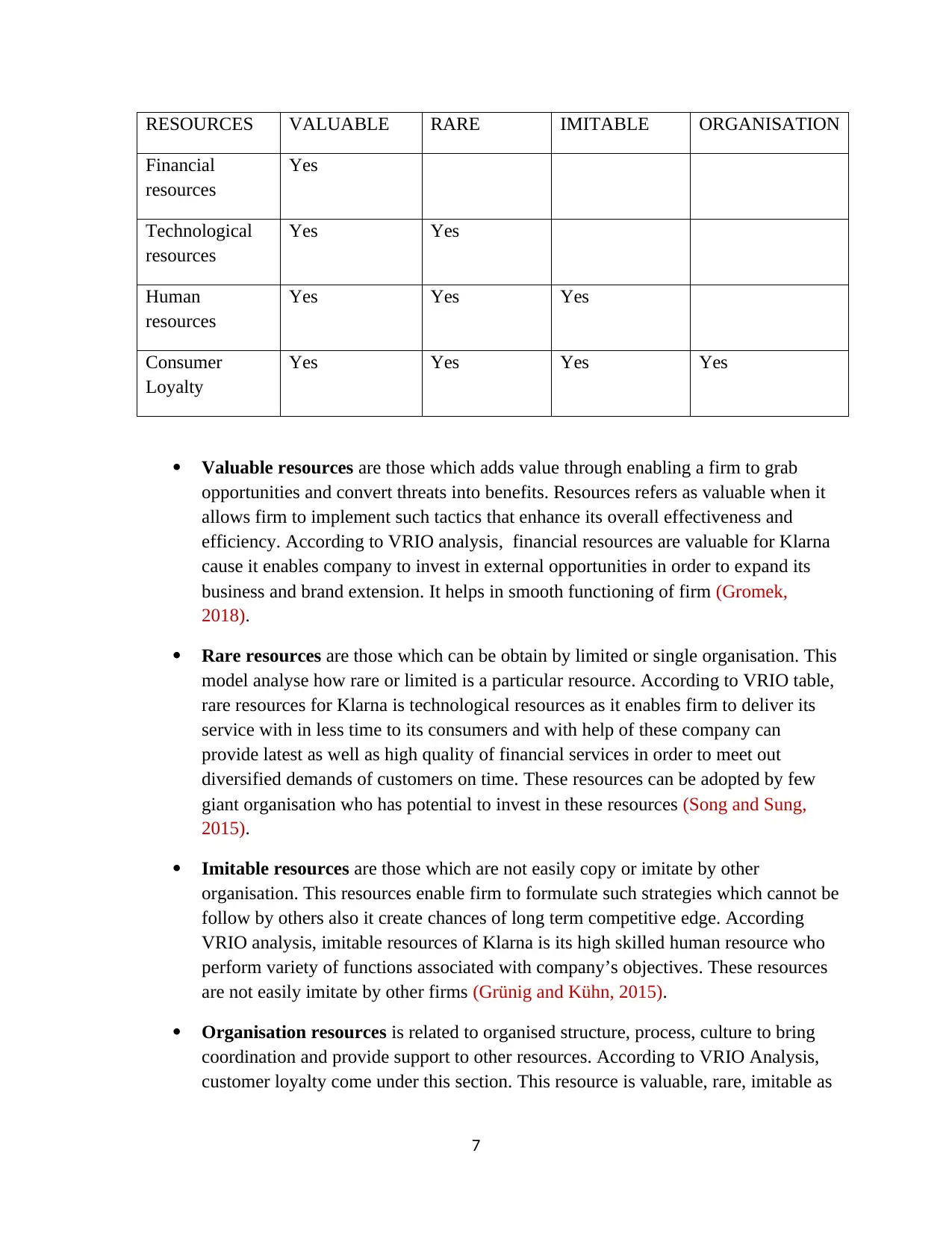
RESOURCES VALUABLE RARE IMITABLE ORGANISATION
Financial
resources
Yes
Technological
resources
Yes Yes
Human
resources
Yes Yes Yes
Consumer
Loyalty
Yes Yes Yes Yes
Valuable resources are those which adds value through enabling a firm to grab
opportunities and convert threats into benefits. Resources refers as valuable when it
allows firm to implement such tactics that enhance its overall effectiveness and
efficiency. According to VRIO analysis, financial resources are valuable for Klarna
cause it enables company to invest in external opportunities in order to expand its
business and brand extension. It helps in smooth functioning of firm (Gromek,
2018).
Rare resources are those which can be obtain by limited or single organisation. This
model analyse how rare or limited is a particular resource. According to VRIO table,
rare resources for Klarna is technological resources as it enables firm to deliver its
service with in less time to its consumers and with help of these company can
provide latest as well as high quality of financial services in order to meet out
diversified demands of customers on time. These resources can be adopted by few
giant organisation who has potential to invest in these resources (Song and Sung,
2015).
Imitable resources are those which are not easily copy or imitate by other
organisation. This resources enable firm to formulate such strategies which cannot be
follow by others also it create chances of long term competitive edge. According
VRIO analysis, imitable resources of Klarna is its high skilled human resource who
perform variety of functions associated with company’s objectives. These resources
are not easily imitate by other firms (Grünig and Kühn, 2015).
Organisation resources is related to organised structure, process, culture to bring
coordination and provide support to other resources. According to VRIO Analysis,
customer loyalty come under this section. This resource is valuable, rare, imitable as
7
Financial
resources
Yes
Technological
resources
Yes Yes
Human
resources
Yes Yes Yes
Consumer
Loyalty
Yes Yes Yes Yes
Valuable resources are those which adds value through enabling a firm to grab
opportunities and convert threats into benefits. Resources refers as valuable when it
allows firm to implement such tactics that enhance its overall effectiveness and
efficiency. According to VRIO analysis, financial resources are valuable for Klarna
cause it enables company to invest in external opportunities in order to expand its
business and brand extension. It helps in smooth functioning of firm (Gromek,
2018).
Rare resources are those which can be obtain by limited or single organisation. This
model analyse how rare or limited is a particular resource. According to VRIO table,
rare resources for Klarna is technological resources as it enables firm to deliver its
service with in less time to its consumers and with help of these company can
provide latest as well as high quality of financial services in order to meet out
diversified demands of customers on time. These resources can be adopted by few
giant organisation who has potential to invest in these resources (Song and Sung,
2015).
Imitable resources are those which are not easily copy or imitate by other
organisation. This resources enable firm to formulate such strategies which cannot be
follow by others also it create chances of long term competitive edge. According
VRIO analysis, imitable resources of Klarna is its high skilled human resource who
perform variety of functions associated with company’s objectives. These resources
are not easily imitate by other firms (Grünig and Kühn, 2015).
Organisation resources is related to organised structure, process, culture to bring
coordination and provide support to other resources. According to VRIO Analysis,
customer loyalty come under this section. This resource is valuable, rare, imitable as
7
Paraphrase This Document
Need a fresh take? Get an instant paraphrase of this document with our AI Paraphraser
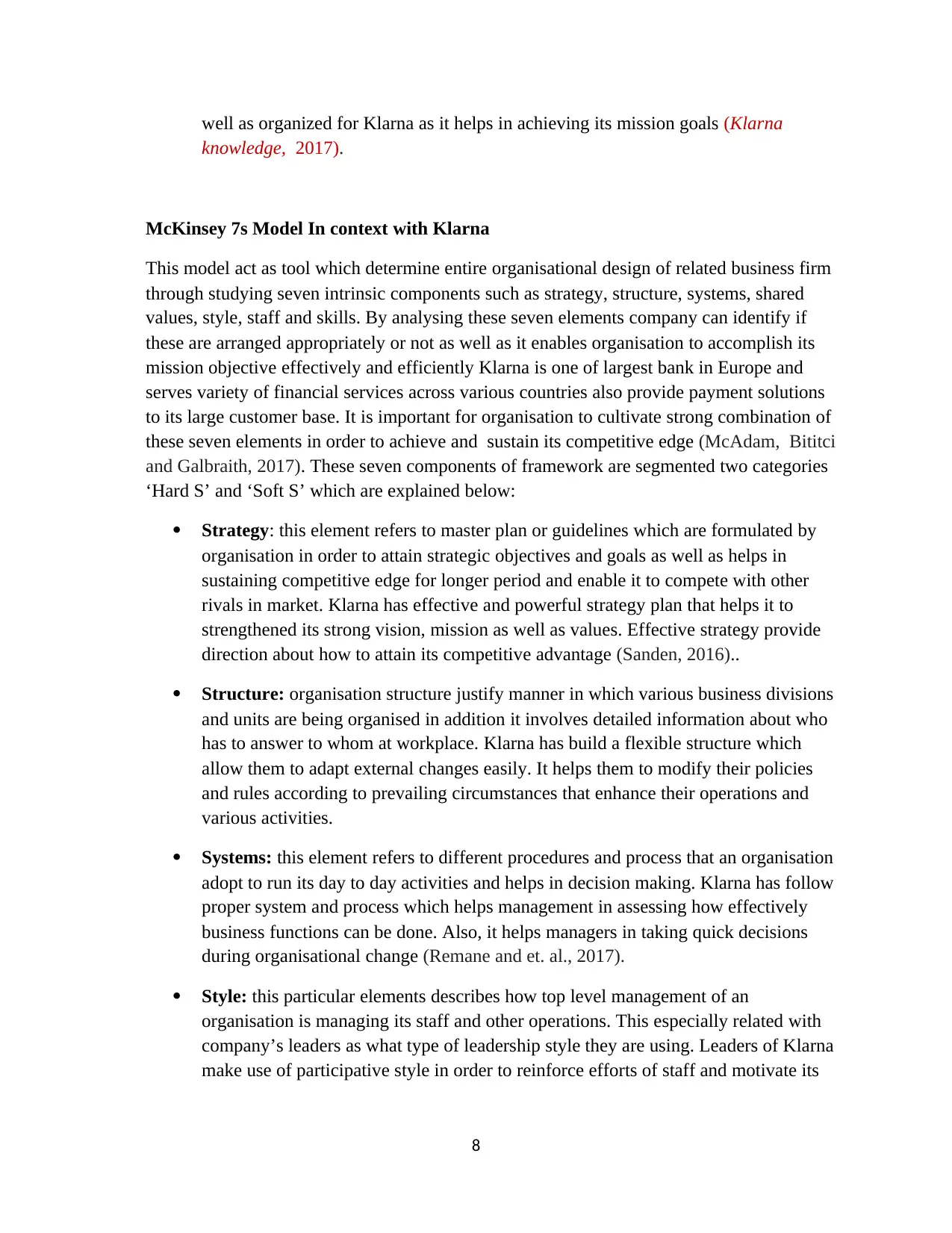
well as organized for Klarna as it helps in achieving its mission goals (Klarna
knowledge, 2017).
McKinsey 7s Model In context with Klarna
This model act as tool which determine entire organisational design of related business firm
through studying seven intrinsic components such as strategy, structure, systems, shared
values, style, staff and skills. By analysing these seven elements company can identify if
these are arranged appropriately or not as well as it enables organisation to accomplish its
mission objective effectively and efficiently Klarna is one of largest bank in Europe and
serves variety of financial services across various countries also provide payment solutions
to its large customer base. It is important for organisation to cultivate strong combination of
these seven elements in order to achieve and sustain its competitive edge (McAdam, Bititci
and Galbraith, 2017). These seven components of framework are segmented two categories
‘Hard S’ and ‘Soft S’ which are explained below:
Strategy: this element refers to master plan or guidelines which are formulated by
organisation in order to attain strategic objectives and goals as well as helps in
sustaining competitive edge for longer period and enable it to compete with other
rivals in market. Klarna has effective and powerful strategy plan that helps it to
strengthened its strong vision, mission as well as values. Effective strategy provide
direction about how to attain its competitive advantage (Sanden, 2016)..
Structure: organisation structure justify manner in which various business divisions
and units are being organised in addition it involves detailed information about who
has to answer to whom at workplace. Klarna has build a flexible structure which
allow them to adapt external changes easily. It helps them to modify their policies
and rules according to prevailing circumstances that enhance their operations and
various activities.
Systems: this element refers to different procedures and process that an organisation
adopt to run its day to day activities and helps in decision making. Klarna has follow
proper system and process which helps management in assessing how effectively
business functions can be done. Also, it helps managers in taking quick decisions
during organisational change (Remane and et. al., 2017).
Style: this particular elements describes how top level management of an
organisation is managing its staff and other operations. This especially related with
company’s leaders as what type of leadership style they are using. Leaders of Klarna
make use of participative style in order to reinforce efforts of staff and motivate its
8
knowledge, 2017).
McKinsey 7s Model In context with Klarna
This model act as tool which determine entire organisational design of related business firm
through studying seven intrinsic components such as strategy, structure, systems, shared
values, style, staff and skills. By analysing these seven elements company can identify if
these are arranged appropriately or not as well as it enables organisation to accomplish its
mission objective effectively and efficiently Klarna is one of largest bank in Europe and
serves variety of financial services across various countries also provide payment solutions
to its large customer base. It is important for organisation to cultivate strong combination of
these seven elements in order to achieve and sustain its competitive edge (McAdam, Bititci
and Galbraith, 2017). These seven components of framework are segmented two categories
‘Hard S’ and ‘Soft S’ which are explained below:
Strategy: this element refers to master plan or guidelines which are formulated by
organisation in order to attain strategic objectives and goals as well as helps in
sustaining competitive edge for longer period and enable it to compete with other
rivals in market. Klarna has effective and powerful strategy plan that helps it to
strengthened its strong vision, mission as well as values. Effective strategy provide
direction about how to attain its competitive advantage (Sanden, 2016)..
Structure: organisation structure justify manner in which various business divisions
and units are being organised in addition it involves detailed information about who
has to answer to whom at workplace. Klarna has build a flexible structure which
allow them to adapt external changes easily. It helps them to modify their policies
and rules according to prevailing circumstances that enhance their operations and
various activities.
Systems: this element refers to different procedures and process that an organisation
adopt to run its day to day activities and helps in decision making. Klarna has follow
proper system and process which helps management in assessing how effectively
business functions can be done. Also, it helps managers in taking quick decisions
during organisational change (Remane and et. al., 2017).
Style: this particular elements describes how top level management of an
organisation is managing its staff and other operations. This especially related with
company’s leaders as what type of leadership style they are using. Leaders of Klarna
make use of participative style in order to reinforce efforts of staff and motivate its
8
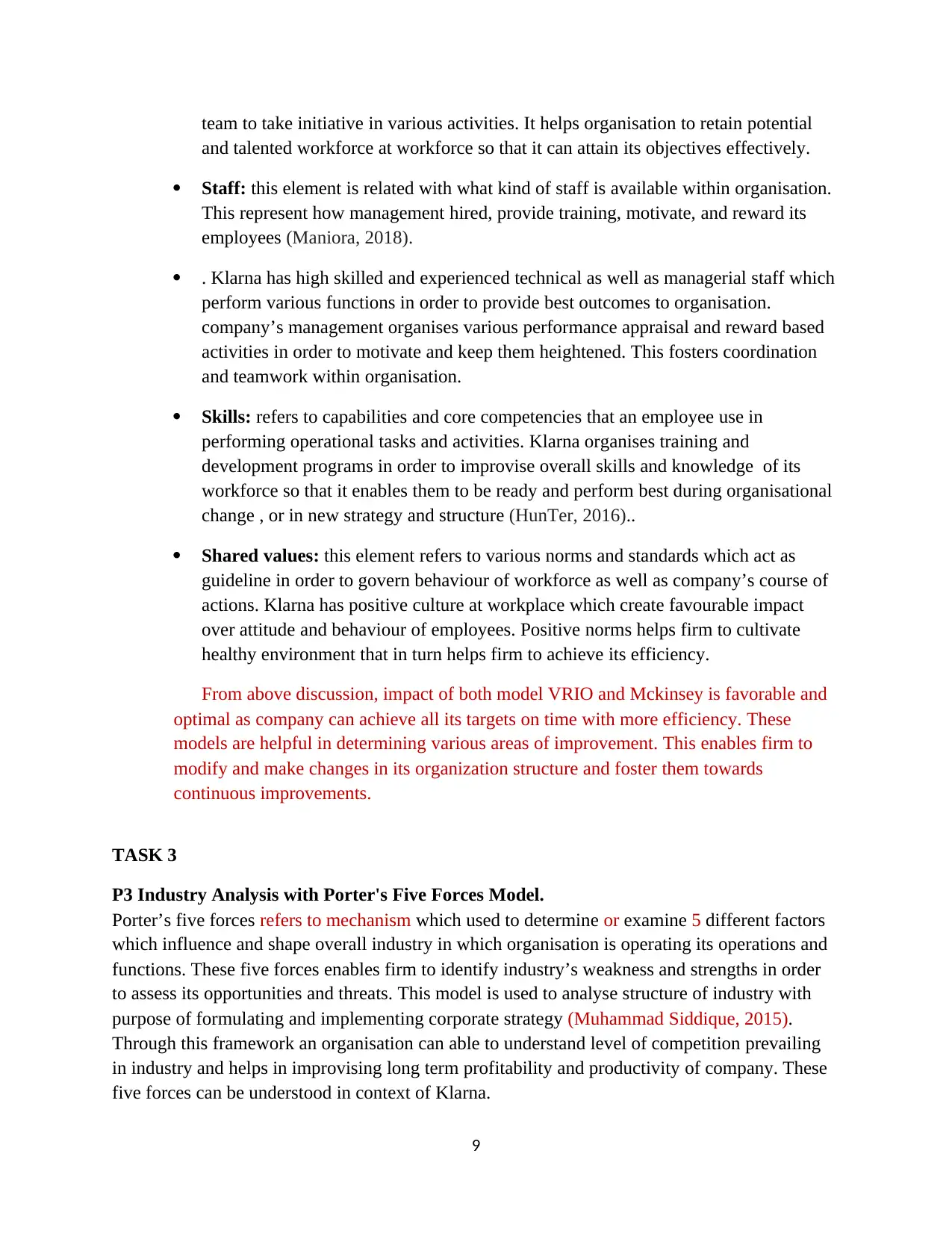
team to take initiative in various activities. It helps organisation to retain potential
and talented workforce at workforce so that it can attain its objectives effectively.
Staff: this element is related with what kind of staff is available within organisation.
This represent how management hired, provide training, motivate, and reward its
employees (Maniora, 2018).
. Klarna has high skilled and experienced technical as well as managerial staff which
perform various functions in order to provide best outcomes to organisation.
company’s management organises various performance appraisal and reward based
activities in order to motivate and keep them heightened. This fosters coordination
and teamwork within organisation.
Skills: refers to capabilities and core competencies that an employee use in
performing operational tasks and activities. Klarna organises training and
development programs in order to improvise overall skills and knowledge of its
workforce so that it enables them to be ready and perform best during organisational
change , or in new strategy and structure (HunTer, 2016)..
Shared values: this element refers to various norms and standards which act as
guideline in order to govern behaviour of workforce as well as company’s course of
actions. Klarna has positive culture at workplace which create favourable impact
over attitude and behaviour of employees. Positive norms helps firm to cultivate
healthy environment that in turn helps firm to achieve its efficiency.
From above discussion, impact of both model VRIO and Mckinsey is favorable and
optimal as company can achieve all its targets on time with more efficiency. These
models are helpful in determining various areas of improvement. This enables firm to
modify and make changes in its organization structure and foster them towards
continuous improvements.
TASK 3
P3 Industry Analysis with Porter's Five Forces Model.
Porter’s five forces refers to mechanism which used to determine or examine 5 different factors
which influence and shape overall industry in which organisation is operating its operations and
functions. These five forces enables firm to identify industry’s weakness and strengths in order
to assess its opportunities and threats. This model is used to analyse structure of industry with
purpose of formulating and implementing corporate strategy (Muhammad Siddique, 2015).
Through this framework an organisation can able to understand level of competition prevailing
in industry and helps in improvising long term profitability and productivity of company. These
five forces can be understood in context of Klarna.
9
and talented workforce at workforce so that it can attain its objectives effectively.
Staff: this element is related with what kind of staff is available within organisation.
This represent how management hired, provide training, motivate, and reward its
employees (Maniora, 2018).
. Klarna has high skilled and experienced technical as well as managerial staff which
perform various functions in order to provide best outcomes to organisation.
company’s management organises various performance appraisal and reward based
activities in order to motivate and keep them heightened. This fosters coordination
and teamwork within organisation.
Skills: refers to capabilities and core competencies that an employee use in
performing operational tasks and activities. Klarna organises training and
development programs in order to improvise overall skills and knowledge of its
workforce so that it enables them to be ready and perform best during organisational
change , or in new strategy and structure (HunTer, 2016)..
Shared values: this element refers to various norms and standards which act as
guideline in order to govern behaviour of workforce as well as company’s course of
actions. Klarna has positive culture at workplace which create favourable impact
over attitude and behaviour of employees. Positive norms helps firm to cultivate
healthy environment that in turn helps firm to achieve its efficiency.
From above discussion, impact of both model VRIO and Mckinsey is favorable and
optimal as company can achieve all its targets on time with more efficiency. These
models are helpful in determining various areas of improvement. This enables firm to
modify and make changes in its organization structure and foster them towards
continuous improvements.
TASK 3
P3 Industry Analysis with Porter's Five Forces Model.
Porter’s five forces refers to mechanism which used to determine or examine 5 different factors
which influence and shape overall industry in which organisation is operating its operations and
functions. These five forces enables firm to identify industry’s weakness and strengths in order
to assess its opportunities and threats. This model is used to analyse structure of industry with
purpose of formulating and implementing corporate strategy (Muhammad Siddique, 2015).
Through this framework an organisation can able to understand level of competition prevailing
in industry and helps in improvising long term profitability and productivity of company. These
five forces can be understood in context of Klarna.
9
⊘ This is a preview!⊘
Do you want full access?
Subscribe today to unlock all pages.

Trusted by 1+ million students worldwide
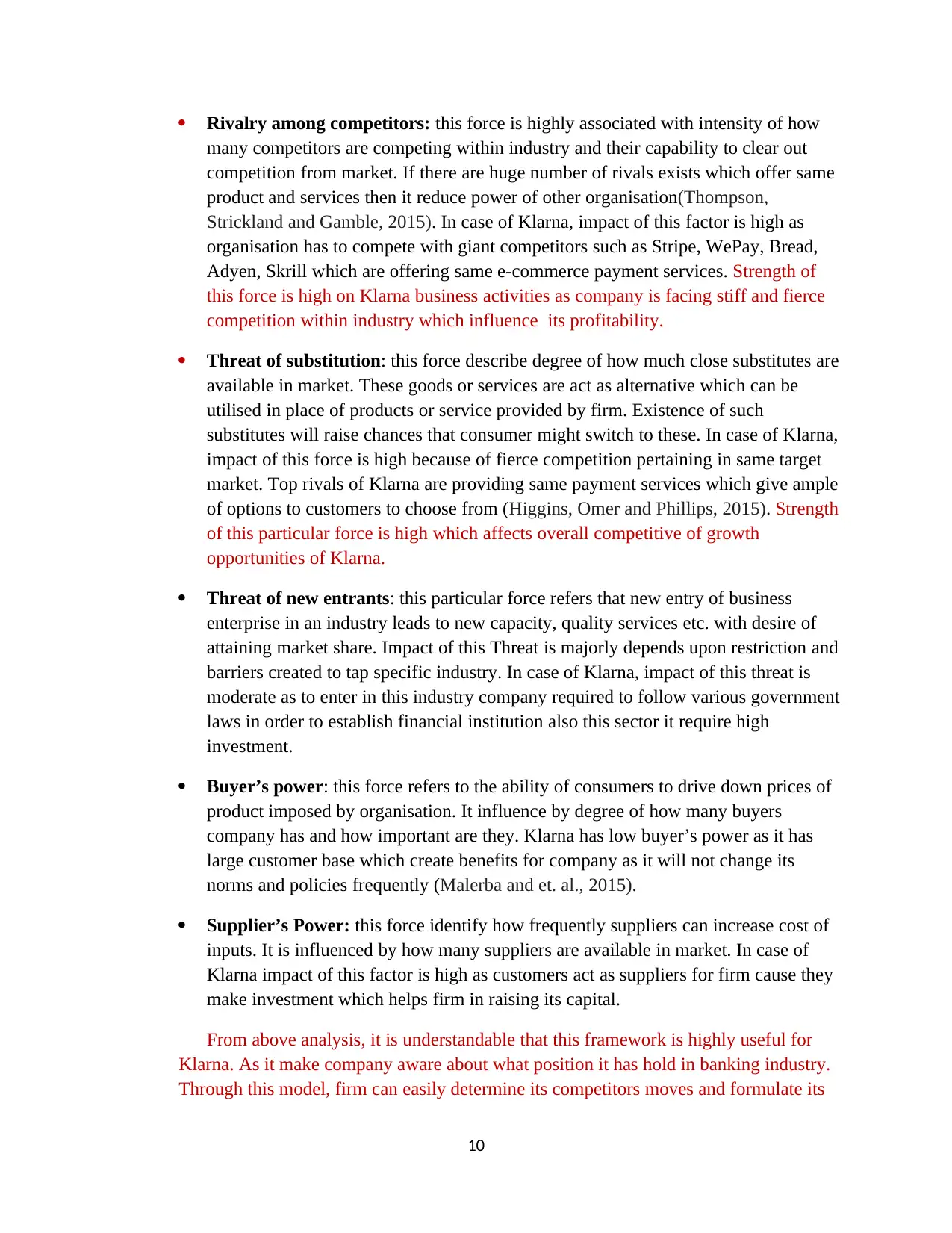
Rivalry among competitors: this force is highly associated with intensity of how
many competitors are competing within industry and their capability to clear out
competition from market. If there are huge number of rivals exists which offer same
product and services then it reduce power of other organisation(Thompson,
Strickland and Gamble, 2015). In case of Klarna, impact of this factor is high as
organisation has to compete with giant competitors such as Stripe, WePay, Bread,
Adyen, Skrill which are offering same e-commerce payment services. Strength of
this force is high on Klarna business activities as company is facing stiff and fierce
competition within industry which influence its profitability.
Threat of substitution: this force describe degree of how much close substitutes are
available in market. These goods or services are act as alternative which can be
utilised in place of products or service provided by firm. Existence of such
substitutes will raise chances that consumer might switch to these. In case of Klarna,
impact of this force is high because of fierce competition pertaining in same target
market. Top rivals of Klarna are providing same payment services which give ample
of options to customers to choose from (Higgins, Omer and Phillips, 2015). Strength
of this particular force is high which affects overall competitive of growth
opportunities of Klarna.
Threat of new entrants: this particular force refers that new entry of business
enterprise in an industry leads to new capacity, quality services etc. with desire of
attaining market share. Impact of this Threat is majorly depends upon restriction and
barriers created to tap specific industry. In case of Klarna, impact of this threat is
moderate as to enter in this industry company required to follow various government
laws in order to establish financial institution also this sector it require high
investment.
Buyer’s power: this force refers to the ability of consumers to drive down prices of
product imposed by organisation. It influence by degree of how many buyers
company has and how important are they. Klarna has low buyer’s power as it has
large customer base which create benefits for company as it will not change its
norms and policies frequently (Malerba and et. al., 2015).
Supplier’s Power: this force identify how frequently suppliers can increase cost of
inputs. It is influenced by how many suppliers are available in market. In case of
Klarna impact of this factor is high as customers act as suppliers for firm cause they
make investment which helps firm in raising its capital.
From above analysis, it is understandable that this framework is highly useful for
Klarna. As it make company aware about what position it has hold in banking industry.
Through this model, firm can easily determine its competitors moves and formulate its
10
many competitors are competing within industry and their capability to clear out
competition from market. If there are huge number of rivals exists which offer same
product and services then it reduce power of other organisation(Thompson,
Strickland and Gamble, 2015). In case of Klarna, impact of this factor is high as
organisation has to compete with giant competitors such as Stripe, WePay, Bread,
Adyen, Skrill which are offering same e-commerce payment services. Strength of
this force is high on Klarna business activities as company is facing stiff and fierce
competition within industry which influence its profitability.
Threat of substitution: this force describe degree of how much close substitutes are
available in market. These goods or services are act as alternative which can be
utilised in place of products or service provided by firm. Existence of such
substitutes will raise chances that consumer might switch to these. In case of Klarna,
impact of this force is high because of fierce competition pertaining in same target
market. Top rivals of Klarna are providing same payment services which give ample
of options to customers to choose from (Higgins, Omer and Phillips, 2015). Strength
of this particular force is high which affects overall competitive of growth
opportunities of Klarna.
Threat of new entrants: this particular force refers that new entry of business
enterprise in an industry leads to new capacity, quality services etc. with desire of
attaining market share. Impact of this Threat is majorly depends upon restriction and
barriers created to tap specific industry. In case of Klarna, impact of this threat is
moderate as to enter in this industry company required to follow various government
laws in order to establish financial institution also this sector it require high
investment.
Buyer’s power: this force refers to the ability of consumers to drive down prices of
product imposed by organisation. It influence by degree of how many buyers
company has and how important are they. Klarna has low buyer’s power as it has
large customer base which create benefits for company as it will not change its
norms and policies frequently (Malerba and et. al., 2015).
Supplier’s Power: this force identify how frequently suppliers can increase cost of
inputs. It is influenced by how many suppliers are available in market. In case of
Klarna impact of this factor is high as customers act as suppliers for firm cause they
make investment which helps firm in raising its capital.
From above analysis, it is understandable that this framework is highly useful for
Klarna. As it make company aware about what position it has hold in banking industry.
Through this model, firm can easily determine its competitors moves and formulate its
10
Paraphrase This Document
Need a fresh take? Get an instant paraphrase of this document with our AI Paraphraser
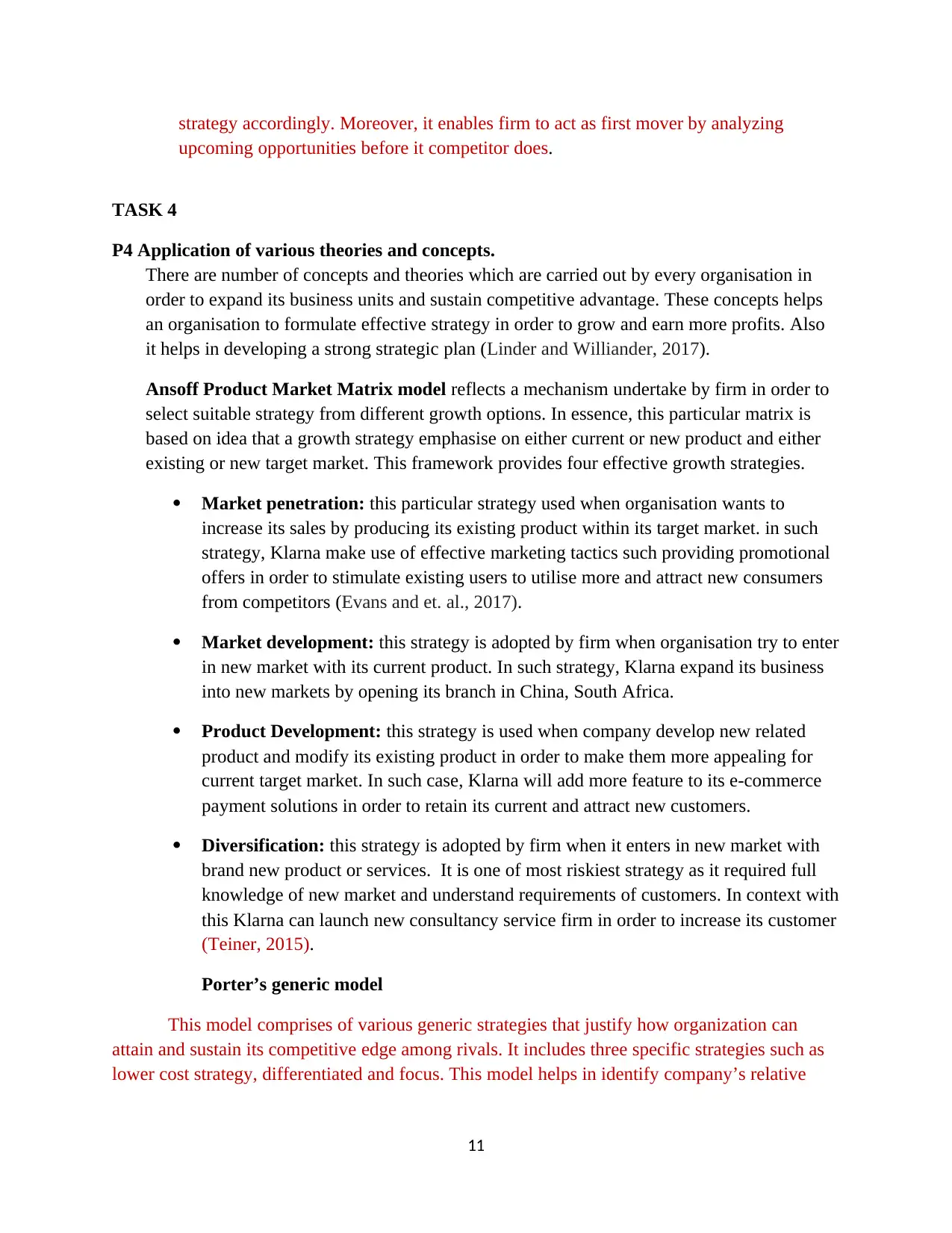
strategy accordingly. Moreover, it enables firm to act as first mover by analyzing
upcoming opportunities before it competitor does.
TASK 4
P4 Application of various theories and concepts.
There are number of concepts and theories which are carried out by every organisation in
order to expand its business units and sustain competitive advantage. These concepts helps
an organisation to formulate effective strategy in order to grow and earn more profits. Also
it helps in developing a strong strategic plan (Linder and Williander, 2017).
Ansoff Product Market Matrix model reflects a mechanism undertake by firm in order to
select suitable strategy from different growth options. In essence, this particular matrix is
based on idea that a growth strategy emphasise on either current or new product and either
existing or new target market. This framework provides four effective growth strategies.
Market penetration: this particular strategy used when organisation wants to
increase its sales by producing its existing product within its target market. in such
strategy, Klarna make use of effective marketing tactics such providing promotional
offers in order to stimulate existing users to utilise more and attract new consumers
from competitors (Evans and et. al., 2017).
Market development: this strategy is adopted by firm when organisation try to enter
in new market with its current product. In such strategy, Klarna expand its business
into new markets by opening its branch in China, South Africa.
Product Development: this strategy is used when company develop new related
product and modify its existing product in order to make them more appealing for
current target market. In such case, Klarna will add more feature to its e-commerce
payment solutions in order to retain its current and attract new customers.
Diversification: this strategy is adopted by firm when it enters in new market with
brand new product or services. It is one of most riskiest strategy as it required full
knowledge of new market and understand requirements of customers. In context with
this Klarna can launch new consultancy service firm in order to increase its customer
(Teiner, 2015).
Porter’s generic model
This model comprises of various generic strategies that justify how organization can
attain and sustain its competitive edge among rivals. It includes three specific strategies such as
lower cost strategy, differentiated and focus. This model helps in identify company’s relative
11
upcoming opportunities before it competitor does.
TASK 4
P4 Application of various theories and concepts.
There are number of concepts and theories which are carried out by every organisation in
order to expand its business units and sustain competitive advantage. These concepts helps
an organisation to formulate effective strategy in order to grow and earn more profits. Also
it helps in developing a strong strategic plan (Linder and Williander, 2017).
Ansoff Product Market Matrix model reflects a mechanism undertake by firm in order to
select suitable strategy from different growth options. In essence, this particular matrix is
based on idea that a growth strategy emphasise on either current or new product and either
existing or new target market. This framework provides four effective growth strategies.
Market penetration: this particular strategy used when organisation wants to
increase its sales by producing its existing product within its target market. in such
strategy, Klarna make use of effective marketing tactics such providing promotional
offers in order to stimulate existing users to utilise more and attract new consumers
from competitors (Evans and et. al., 2017).
Market development: this strategy is adopted by firm when organisation try to enter
in new market with its current product. In such strategy, Klarna expand its business
into new markets by opening its branch in China, South Africa.
Product Development: this strategy is used when company develop new related
product and modify its existing product in order to make them more appealing for
current target market. In such case, Klarna will add more feature to its e-commerce
payment solutions in order to retain its current and attract new customers.
Diversification: this strategy is adopted by firm when it enters in new market with
brand new product or services. It is one of most riskiest strategy as it required full
knowledge of new market and understand requirements of customers. In context with
this Klarna can launch new consultancy service firm in order to increase its customer
(Teiner, 2015).
Porter’s generic model
This model comprises of various generic strategies that justify how organization can
attain and sustain its competitive edge among rivals. It includes three specific strategies such as
lower cost strategy, differentiated and focus. This model helps in identify company’s relative
11
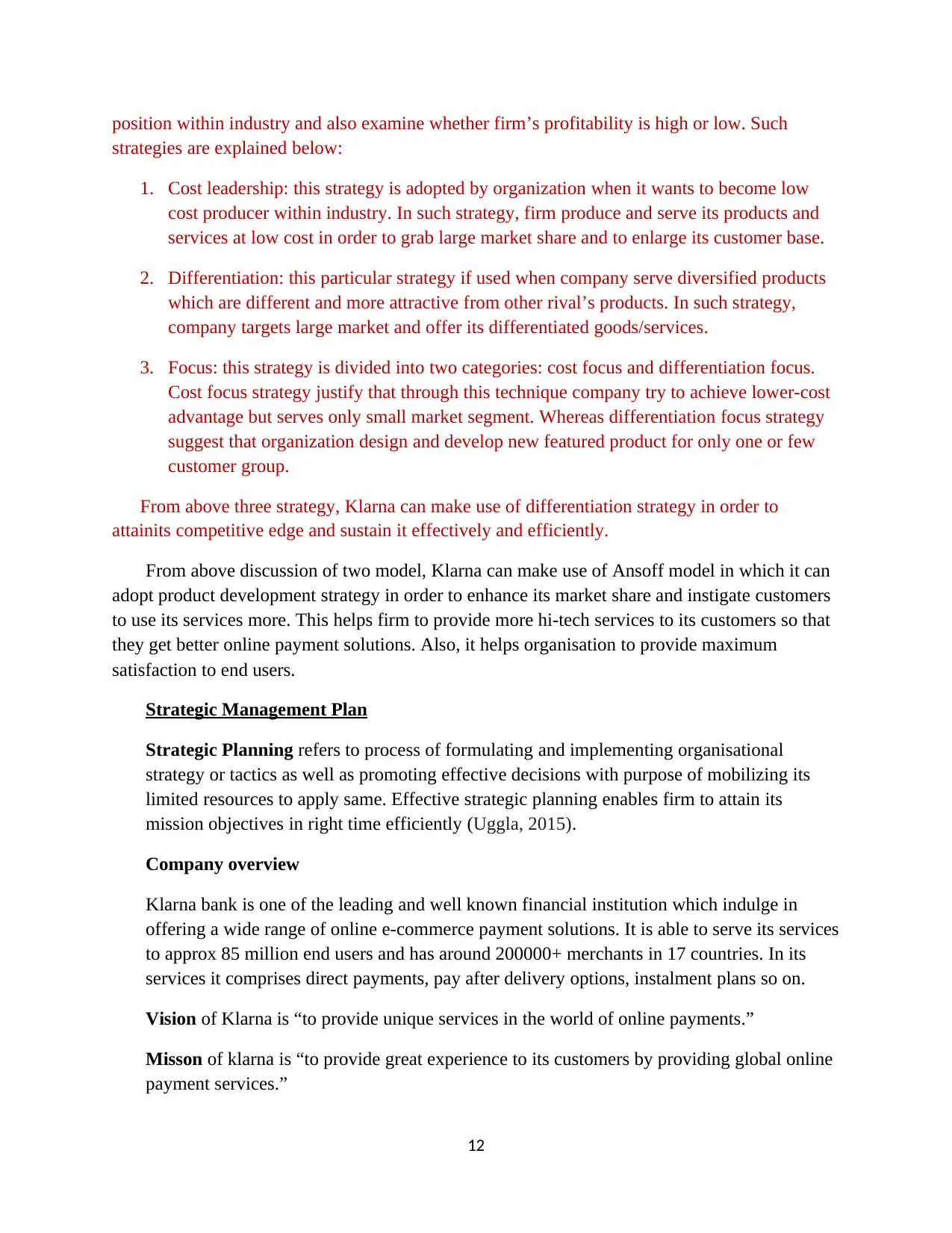
position within industry and also examine whether firm’s profitability is high or low. Such
strategies are explained below:
1. Cost leadership: this strategy is adopted by organization when it wants to become low
cost producer within industry. In such strategy, firm produce and serve its products and
services at low cost in order to grab large market share and to enlarge its customer base.
2. Differentiation: this particular strategy if used when company serve diversified products
which are different and more attractive from other rival’s products. In such strategy,
company targets large market and offer its differentiated goods/services.
3. Focus: this strategy is divided into two categories: cost focus and differentiation focus.
Cost focus strategy justify that through this technique company try to achieve lower-cost
advantage but serves only small market segment. Whereas differentiation focus strategy
suggest that organization design and develop new featured product for only one or few
customer group.
From above three strategy, Klarna can make use of differentiation strategy in order to
attainits competitive edge and sustain it effectively and efficiently.
From above discussion of two model, Klarna can make use of Ansoff model in which it can
adopt product development strategy in order to enhance its market share and instigate customers
to use its services more. This helps firm to provide more hi-tech services to its customers so that
they get better online payment solutions. Also, it helps organisation to provide maximum
satisfaction to end users.
Strategic Management Plan
Strategic Planning refers to process of formulating and implementing organisational
strategy or tactics as well as promoting effective decisions with purpose of mobilizing its
limited resources to apply same. Effective strategic planning enables firm to attain its
mission objectives in right time efficiently (Uggla, 2015).
Company overview
Klarna bank is one of the leading and well known financial institution which indulge in
offering a wide range of online e-commerce payment solutions. It is able to serve its services
to approx 85 million end users and has around 200000+ merchants in 17 countries. In its
services it comprises direct payments, pay after delivery options, instalment plans so on.
Vision of Klarna is “to provide unique services in the world of online payments.”
Misson of klarna is “to provide great experience to its customers by providing global online
payment services.”
12
strategies are explained below:
1. Cost leadership: this strategy is adopted by organization when it wants to become low
cost producer within industry. In such strategy, firm produce and serve its products and
services at low cost in order to grab large market share and to enlarge its customer base.
2. Differentiation: this particular strategy if used when company serve diversified products
which are different and more attractive from other rival’s products. In such strategy,
company targets large market and offer its differentiated goods/services.
3. Focus: this strategy is divided into two categories: cost focus and differentiation focus.
Cost focus strategy justify that through this technique company try to achieve lower-cost
advantage but serves only small market segment. Whereas differentiation focus strategy
suggest that organization design and develop new featured product for only one or few
customer group.
From above three strategy, Klarna can make use of differentiation strategy in order to
attainits competitive edge and sustain it effectively and efficiently.
From above discussion of two model, Klarna can make use of Ansoff model in which it can
adopt product development strategy in order to enhance its market share and instigate customers
to use its services more. This helps firm to provide more hi-tech services to its customers so that
they get better online payment solutions. Also, it helps organisation to provide maximum
satisfaction to end users.
Strategic Management Plan
Strategic Planning refers to process of formulating and implementing organisational
strategy or tactics as well as promoting effective decisions with purpose of mobilizing its
limited resources to apply same. Effective strategic planning enables firm to attain its
mission objectives in right time efficiently (Uggla, 2015).
Company overview
Klarna bank is one of the leading and well known financial institution which indulge in
offering a wide range of online e-commerce payment solutions. It is able to serve its services
to approx 85 million end users and has around 200000+ merchants in 17 countries. In its
services it comprises direct payments, pay after delivery options, instalment plans so on.
Vision of Klarna is “to provide unique services in the world of online payments.”
Misson of klarna is “to provide great experience to its customers by providing global online
payment services.”
12
⊘ This is a preview!⊘
Do you want full access?
Subscribe today to unlock all pages.

Trusted by 1+ million students worldwide
1 out of 18
Related Documents
Your All-in-One AI-Powered Toolkit for Academic Success.
+13062052269
info@desklib.com
Available 24*7 on WhatsApp / Email
![[object Object]](/_next/static/media/star-bottom.7253800d.svg)
Unlock your academic potential
Copyright © 2020–2025 A2Z Services. All Rights Reserved. Developed and managed by ZUCOL.




